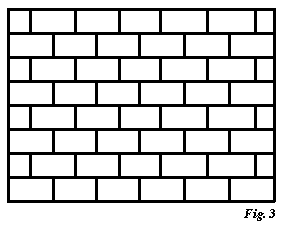90 THE STONES OF VENICE CONSTRUCTION
Angelo, who turned heroes’ limbs into surgeons’ diagrams,-but with less excuse than theirs, for there is less interest in the anatomy displayed. Exhibited masonry is in most cases the expedient of architects who do not know how to fill up blank spaces, and many a building, which would have been decent enough  if let alone, has been scrawled over with straight lines, as in Fig. 3, on exactly the same principles, and with just the same amount of intelligence as a boy’s in scrawling his copy-book when he cannot write. The device was thought ingenious at one period of architectural history: St. Paul’s and Whitehall1 are covered with it, and it is in this I imagine that some of our modern architects suppose the great merit of those buildings to consist. There is, however, no excuse for errors in disposition of masonry, for there is but one law upon the subject, and that easily complied with, to avoid all affectation and all unnecessary expense, either in showing or concealing. Every one knows a building is built of separate stones; nobody will ever object to seeing that it is so, but nobody wants to count them. The divisions of a church are much like the divisions of a sermon; they are always right, so long as they are necessary to edification, and always wrong when they are thrust upon the attention as divisions only. There may be neatness in carving when there is richness in feasting; but I have heard many a discourse, and seen many a church wall, in which it was all carving and no meat.
if let alone, has been scrawled over with straight lines, as in Fig. 3, on exactly the same principles, and with just the same amount of intelligence as a boy’s in scrawling his copy-book when he cannot write. The device was thought ingenious at one period of architectural history: St. Paul’s and Whitehall1 are covered with it, and it is in this I imagine that some of our modern architects suppose the great merit of those buildings to consist. There is, however, no excuse for errors in disposition of masonry, for there is but one law upon the subject, and that easily complied with, to avoid all affectation and all unnecessary expense, either in showing or concealing. Every one knows a building is built of separate stones; nobody will ever object to seeing that it is so, but nobody wants to count them. The divisions of a church are much like the divisions of a sermon; they are always right, so long as they are necessary to edification, and always wrong when they are thrust upon the attention as divisions only. There may be neatness in carving when there is richness in feasting; but I have heard many a discourse, and seen many a church wall, in which it was all carving and no meat.
1 [St. Paul’s, it will be remembered, was built 1675-1710; the Banqueting Hall, Whitehall (by Inigo Jones), in 1619-1622.]
[Version 0.04: March 2008]
